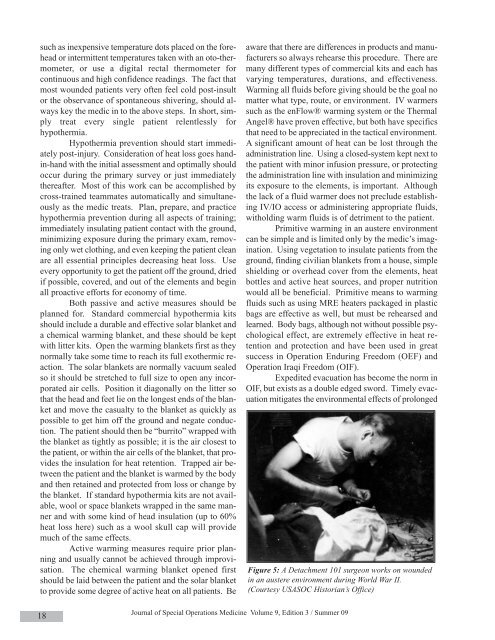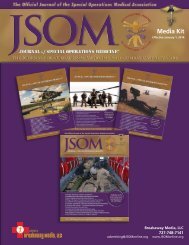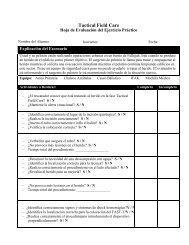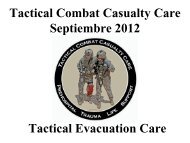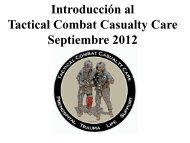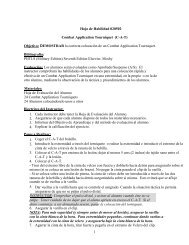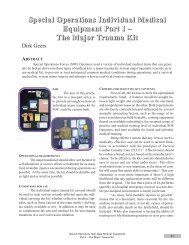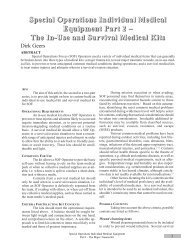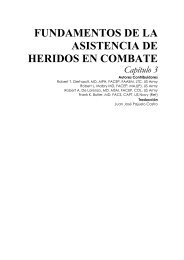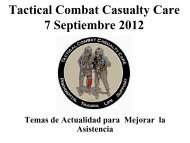Risk G. Hetzler M. Damage Control Resuscitation for the Special ...
Risk G. Hetzler M. Damage Control Resuscitation for the Special ...
Risk G. Hetzler M. Damage Control Resuscitation for the Special ...
You also want an ePaper? Increase the reach of your titles
YUMPU automatically turns print PDFs into web optimized ePapers that Google loves.
such as inexpensive temperature dots placed on <strong>the</strong> <strong>for</strong>ehead<br />
or intermittent temperatures taken with an oto-<strong>the</strong>rmometer,<br />
or use a digital rectal <strong>the</strong>rmometer <strong>for</strong><br />
continuous and high confidence readings. The fact that<br />
most wounded patients very often feel cold post-insult<br />
or <strong>the</strong> observance of spontaneous shivering, should always<br />
key <strong>the</strong> medic in to <strong>the</strong> above steps. In short, simply<br />
treat every single patient relentlessly <strong>for</strong><br />
hypo<strong>the</strong>rmia.<br />
Hypo<strong>the</strong>rmia prevention should start immediately<br />
post-injury. Consideration of heat loss goes handin-hand<br />
with <strong>the</strong> initial assessment and optimally should<br />
occur during <strong>the</strong> primary survey or just immediately<br />
<strong>the</strong>reafter. Most of this work can be accomplished by<br />
cross-trained teammates automatically and simultaneously<br />
as <strong>the</strong> medic treats. Plan, prepare, and practice<br />
hypo<strong>the</strong>rmia prevention during all aspects of training;<br />
immediately insulating patient contact with <strong>the</strong> ground,<br />
minimizing exposure during <strong>the</strong> primary exam, removing<br />
only wet clothing, and even keeping <strong>the</strong> patient clean<br />
are all essential principles decreasing heat loss. Use<br />
every opportunity to get <strong>the</strong> patient off <strong>the</strong> ground, dried<br />
if possible, covered, and out of <strong>the</strong> elements and begin<br />
all proactive ef<strong>for</strong>ts <strong>for</strong> economy of time.<br />
Both passive and active measures should be<br />
planned <strong>for</strong>. Standard commercial hypo<strong>the</strong>rmia kits<br />
should include a durable and effective solar blanket and<br />
a chemical warming blanket, and <strong>the</strong>se should be kept<br />
with litter kits. Open <strong>the</strong> warming blankets first as <strong>the</strong>y<br />
normally take some time to reach its full exo<strong>the</strong>rmic reaction.<br />
The solar blankets are normally vacuum sealed<br />
so it should be stretched to full size to open any incorporated<br />
air cells. Position it diagonally on <strong>the</strong> litter so<br />
that <strong>the</strong> head and feet lie on <strong>the</strong> longest ends of <strong>the</strong> blanket<br />
and move <strong>the</strong> casualty to <strong>the</strong> blanket as quickly as<br />
possible to get him off <strong>the</strong> ground and negate conduction.<br />
The patient should <strong>the</strong>n be “burrito” wrapped with<br />
<strong>the</strong> blanket as tightly as possible; it is <strong>the</strong> air closest to<br />
<strong>the</strong> patient, or within <strong>the</strong> air cells of <strong>the</strong> blanket, that provides<br />
<strong>the</strong> insulation <strong>for</strong> heat retention. Trapped air between<br />
<strong>the</strong> patient and <strong>the</strong> blanket is warmed by <strong>the</strong> body<br />
and <strong>the</strong>n retained and protected from loss or change by<br />
<strong>the</strong> blanket. If standard hypo<strong>the</strong>rmia kits are not available,<br />
wool or space blankets wrapped in <strong>the</strong> same manner<br />
and with some kind of head insulation (up to 60%<br />
heat loss here) such as a wool skull cap will provide<br />
much of <strong>the</strong> same effects.<br />
Active warming measures require prior planning<br />
and usually cannot be achieved through improvisation.<br />
The chemical warming blanket opened first<br />
should be laid between <strong>the</strong> patient and <strong>the</strong> solar blanket<br />
to provide some degree of active heat on all patients. Be<br />
aware that <strong>the</strong>re are differences in products and manufacturers<br />
so always rehearse this procedure. There are<br />
many different types of commercial kits and each has<br />
varying temperatures, durations, and effectiveness.<br />
Warming all fluids be<strong>for</strong>e giving should be <strong>the</strong> goal no<br />
matter what type, route, or environment. IV warmers<br />
such as <strong>the</strong> enFlow® warming system or <strong>the</strong> Thermal<br />
Angel® have proven effective, but both have specifics<br />
that need to be appreciated in <strong>the</strong> tactical environment.<br />
A significant amount of heat can be lost through <strong>the</strong><br />
administration line. Using a closed-system kept next to<br />
<strong>the</strong> patient with minor infusion pressure, or protecting<br />
<strong>the</strong> administration line with insulation and minimizing<br />
its exposure to <strong>the</strong> elements, is important. Although<br />
<strong>the</strong> lack of a fluid warmer does not preclude establishing<br />
IV/IO access or administering appropriate fluids,<br />
witholding warm fluids is of detriment to <strong>the</strong> patient.<br />
Primitive warming in an austere environment<br />
can be simple and is limited only by <strong>the</strong> medic’s imagination.<br />
Using vegetation to insulate patients from <strong>the</strong><br />
ground, finding civilian blankets from a house, simple<br />
shielding or overhead cover from <strong>the</strong> elements, heat<br />
bottles and active heat sources, and proper nutrition<br />
would all be beneficial. Primitive means to warming<br />
fluids such as using MRE heaters packaged in plastic<br />
bags are effective as well, but must be rehearsed and<br />
learned. Body bags, although not without possible psychological<br />
effect, are extremely effective in heat retention<br />
and protection and have been used in great<br />
success in Operation Enduring Freedom (OEF) and<br />
Operation Iraqi Freedom (OIF).<br />
Expedited evacuation has become <strong>the</strong> norm in<br />
OIF, but exists as a double edged sword. Timely evacuation<br />
mitigates <strong>the</strong> environmental effects of prolonged<br />
Figure 5: A Detachment 101 surgeon works on wounded<br />
in an austere environment during World War II.<br />
(Courtesy USASOC Historian’s Office)<br />
18<br />
Journal of <strong>Special</strong> Operations Medicine Volume 9, Edition 3 / Summer 09


